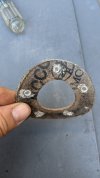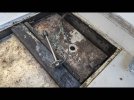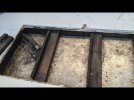yup! I have a facility here that takes it - all in a 5gallon cans!This may have been covered here already but I had almost 40 gallons of bad gas to dispose of a while back and I was able to make a call to my local sanitation/recycling center and they gave me an appointment to bring it in to them for disposal. They were very good about it....I think they make it easy so you don't do the wrong thing. Good luck with all this.
BTW.....I just siphoned it into 5 gal cans.
You are using an out of date browser. It may not display this or other websites correctly.
You should upgrade or use an alternative browser.
You should upgrade or use an alternative browser.
Alarm on Yamaha F150
- Thread starter TonyD
- Start date
So, never called Somers Point - I hooked up a 2gallon external can to the motor.. (actually, I hooked up through the water separator housing first) So, primed the motor with the new gas - water did come out through the VST - but once I saw gas.. I closed off the VST - turned the key and the alarm went off again. Water in the line somewhere.
Checked the in-line fuel filer.. water in there - checked the water separator... I had filled it with clean gas when I placed it back onto the housing, so that was okay. Went back to the VST, primed and pumped... more water came out.. just kept at it until, priming and pumping.. finally I was sure it was all gas. Turned the key, no alarm!
Now, cranked the motor.. wouldn't start or a very hard time starting. A lot of rough starting and stalling. No alarms though, no lights. Finally, got it to start.. it ran very rough at first.. then smoothed out. Shut it down. Waited a few minutes. Started up again with no issue. Repeated and consistent result. So, I think the motor is okay now.. that rough start did (and still does kind of concern me but all things considered I guess it makes sense). But I am wondering if I should still have the marina take a look at it.
Good news, I dropped the lower unit oil and that looks normal. No water in my lower unit!
As far the water issue in the fuel lines, while I was messing with the water separator, could that have let the water into the gas tank if the housing was submerged in water? I plan to change all those fuel lines since I am certain that those lines were also sitting in a pool of water in the back bilge area.
Checked the in-line fuel filer.. water in there - checked the water separator... I had filled it with clean gas when I placed it back onto the housing, so that was okay. Went back to the VST, primed and pumped... more water came out.. just kept at it until, priming and pumping.. finally I was sure it was all gas. Turned the key, no alarm!
Now, cranked the motor.. wouldn't start or a very hard time starting. A lot of rough starting and stalling. No alarms though, no lights. Finally, got it to start.. it ran very rough at first.. then smoothed out. Shut it down. Waited a few minutes. Started up again with no issue. Repeated and consistent result. So, I think the motor is okay now.. that rough start did (and still does kind of concern me but all things considered I guess it makes sense). But I am wondering if I should still have the marina take a look at it.
Good news, I dropped the lower unit oil and that looks normal. No water in my lower unit!
As far the water issue in the fuel lines, while I was messing with the water separator, could that have let the water into the gas tank if the housing was submerged in water? I plan to change all those fuel lines since I am certain that those lines were also sitting in a pool of water in the back bilge area.
glacierbaze
Well-Known Member
- Joined
- Jul 6, 2012
- Messages
- 2,566
- Reaction score
- 670
- Points
- 113
- Age
- 76
- Model
- Seafarer
DennisG01
GreatGrady Captain
- Joined
- Sep 1, 2013
- Messages
- 7,809
- Reaction score
- 1,542
- Points
- 113
- Location
- Allentown, PA & Friendship, ME
- Model
- Offshore
The purpsoe of using the portable tank was just to make sure the engine runs and get that part (a big part) off your mind. I'm not concerned about it starting hard - in fact, that would have been expected. Nothing there troubles me.
No, I would not expect water to get into the fuel system through the fuel/water seperator if it was screwed on properly. IF it was not, it all depends on the height of the F/W sep as compared to the tank fitting based on the level of the boat... in other words, the water would have had to transfer by gravity. It also would have had to make it's way past the anti-siphon valve (assuming you have one) which is very unlikely to push it's way through that.
No, I would not expect water to get into the fuel system through the fuel/water seperator if it was screwed on properly. IF it was not, it all depends on the height of the F/W sep as compared to the tank fitting based on the level of the boat... in other words, the water would have had to transfer by gravity. It also would have had to make it's way past the anti-siphon valve (assuming you have one) which is very unlikely to push it's way through that.
Okay, great - I wasn't expecting the hard/rough start and running but if the idea that the motor is running is a good sign, then that eases my mind.The purpsoe of using the portable tank was just to make sure the engine runs and get that part (a big part) off your mind. I'm not concerned about it starting hard - in fact, that would have been expected. Nothing there troubles me.
No, I would not expect water to get into the fuel system through the fuel/water seperator if it was screwed on properly. IF it was not, it all depends on the height of the F/W sep as compared to the tank fitting based on the level of the boat... in other words, the water would have had to transfer by gravity. It also would have had to make it's way past the anti-siphon valve (assuming you have one) which is very unlikely to push it's way through that.
As far as the water separator housing, okay - I was just curious, it crossed my mind - I pulled the floor panel this evening but I still need to look at it closely to see where the water could have got into the tank.
I plan to fog the motor and then shrink it up and then deal with the tank in the early spring. Maybe do a compression test on the tank after changing the fuel hoses and see where it goes from there.
Update: Very happy that the engine is working well - I was able to find muffs that work correctly for my size engine and so I ran some fogging oil through the engine, so now the engine is all set for the winter.
I pulled the floor panel and the top of the tank seems to look good. I can't see any noticeable holes on top of or around any fittings on the tank. Although I haven't pulled those 2x4's up yet to see what's going on underneath them. I am not sure there would be a problem though in that area. The sending unit gasket looked pretty good -- I am thinking that the next thing to do is replace all the hoses and then do a pressure test on the tank, maybe that will reveal something.
BTW, I was able to syphon the tank - 50gallons of water! All that sits in the tank now is a little bit of gas. Pics below. but I also found some Hull damage and I am at a point where maybe I just need to sell this boat.. new post coming up!



I pulled the floor panel and the top of the tank seems to look good. I can't see any noticeable holes on top of or around any fittings on the tank. Although I haven't pulled those 2x4's up yet to see what's going on underneath them. I am not sure there would be a problem though in that area. The sending unit gasket looked pretty good -- I am thinking that the next thing to do is replace all the hoses and then do a pressure test on the tank, maybe that will reveal something.
BTW, I was able to syphon the tank - 50gallons of water! All that sits in the tank now is a little bit of gas. Pics below. but I also found some Hull damage and I am at a point where maybe I just need to sell this boat.. new post coming up!



DennisG01
GreatGrady Captain
- Joined
- Sep 1, 2013
- Messages
- 7,809
- Reaction score
- 1,542
- Points
- 113
- Location
- Allentown, PA & Friendship, ME
- Model
- Offshore
Give the tank top a good cleaning and double check. This is something you need to SURE of, not "sort of". FYI, there is a greater chance of holes being under the wood than a lesser chance. The reason is because aluminum does a good job of self protecting itself... but it needs good air flow to do so. I'm not saying there ARE holes there, just mentioning that to redirect your thinking on that.
Gasket... but how does the mating surface look?
I can't really tell, but what's going on with the vent hose? It looks odd.
Yes, pressure test.
I don't recall if you mentioned what engine you have, but if you have a firect fuel injected engine, it's not a good idea to use fogging oil as it can foul the injectors and/or any sensors that may be in the air intake.
Gasket... but how does the mating surface look?
I can't really tell, but what's going on with the vent hose? It looks odd.
Yes, pressure test.
I don't recall if you mentioned what engine you have, but if you have a firect fuel injected engine, it's not a good idea to use fogging oil as it can foul the injectors and/or any sensors that may be in the air intake.
Last edited:
Hookup1
GreatGrady Captain
- Joined
- Oct 16, 2007
- Messages
- 3,575
- Reaction score
- 1,011
- Points
- 113
- Age
- 71
- Location
- Cape May, NJ
- Model
- Islander
The question is how did the water get in the boat! We know you couldn’t get it out from a bad bilge pump switch. Somehow water got in (this is the key question)! It should never have happened! The rest is gravity. Tank leaks, sending units, etc that should never have been underwater. Once you clean up the mess you need to make sure it doesn’t happen again. It’s not the tank hoses that let water it’s the boat/hull!Yeah, I don't know how the water got into the tank yet.. or into the fuel lines - haven't got that far into my "investigation" of everything. But I do know that the gas tank was pretty much submerged in water at some point.
Once I am able to remove the floor board and then the sending unit I should have a better understanding, maybe- hopefully!
Dennis, yeah, I did plan on pulling the 2x4's.. didn't get that chance today like I planned. Hopefully tomorrow. Thanks on the advice of the stronger possibility of an issue underneath the wood.Give the tank top a good cleaning and double check. This is something you need to SURE of, not "sort of". FYI, there is a greater chance of holes being under the wood than a lesser chance. The reason is because aluminum does a good job of self protecting itself... but it needs good air flow to do so. I'm not saying there ARE holes there, just mentioning that to redirect your thinking on that.
Gasket... but how does the mating surface look?
I can't really tell, but what's going on with the vent hose? It looks odd.
Yes, pressure test.
I don't recall if you mentioned what engine you have, but if you have a firect fuel injected engine, it's not a good idea to use fogging oil as it can foul the injectors and/or any sensors that may be in the air intake.
As for fogging, yes, I do have a DFI - a 150 4 stroke Yam. I am also aware that the plugs can get fouled up, I change them every spring however. But on that note, I haven't heard anyone say to NOT fog the engine, would you just leave it with no other alternative to protecting the motor through the winter months?
How did the water get in the boat? Had a NOR'easter, float switch on bilge failed (something else I have to replace in the spring) water filled up in the boat. How that much water got into the gas tank is the mystery. Water IN the boat, not so much a mystery.The question is how did the water get in the boat! We know you couldn’t get it out from a bad bilge pump switch. Somehow water got in (this is the key question)! It should never have happened! The rest is gravity. Tank leaks, sending units, etc that should never have been underwater. Once you clean up the mess you need to make sure it doesn’t happen again. It’s not the tank hoses that let water it’s the boat/hull!
Is the tank vent separate or built into the gas fill fitting?
If external, is it possible that when the bilge filled with water that the gas vent was under water?
If external, is it possible that when the bilge filled with water that the gas vent was under water?
DennisG01
GreatGrady Captain
- Joined
- Sep 1, 2013
- Messages
- 7,809
- Reaction score
- 1,542
- Points
- 113
- Location
- Allentown, PA & Friendship, ME
- Model
- Offshore
No, fogging is still good. It's just done differently to protect the injectors and any sensors that may be in the airstream. You can either mix up a "cocktail" of gas, 2-stroke oil and stabilizer or just pull the plugs and squirt some fogging oil (or regular oil) into the cylinder, then reinsert the plugs and turn the engine over a few times without letting it start. Of course, making sure your fuel is properly stabilized and running the engine for a while before hand is important to protect the injector tips.Dennis, yeah, I did plan on pulling the 2x4's.. didn't get that chance today like I planned. Hopefully tomorrow. Thanks on the advice of the stronger possibility of an issue underneath the wood.
As for fogging, yes, I do have a DFI - a 150 4 stroke Yam. I am also aware that the plugs can get fouled up, I change them every spring however. But on that note, I haven't heard anyone say to NOT fog the engine, would you just leave it with no other alternative to protecting the motor through the winter months?
ahh, okay - I think that's what I did.. first I ran the engine with the external tank of which I had dropped a little bit of the Yamaha gas detergent into. Ran it for.. about maybe 5 minutes? Then, I took 2gallons, again, external tank, mixed a quart of fogging oil with it and ran the engine until smoke started blowing out. That was for about 10 minutes. I might be wrong but would that mixture of the Yamaha fogging oil be just about the same as mixing 2 stroke oil?No, fogging is still good. It's just done differently to protect the injectors and any sensors that may be in the airstream. You can either mix up a "cocktail" of gas, 2-stroke oil and stabilizer or just pull the plugs and squirt some fogging oil (or regular oil) into the cylinder, then reinsert the plugs and turn the engine over a few times without letting it start. Of course, making sure your fuel is properly stabilized and running the engine for a while before hand is important to protect the injector tips.
Yeah, the vent is built into the fill fitting up at the bow. The bow never got under the water line BUT the bilge outlet was below the waterline!Is the tank vent separate or built into the gas fill fitting?
If external, is it possible that when the bilge filled with water that the gas vent was under water?

